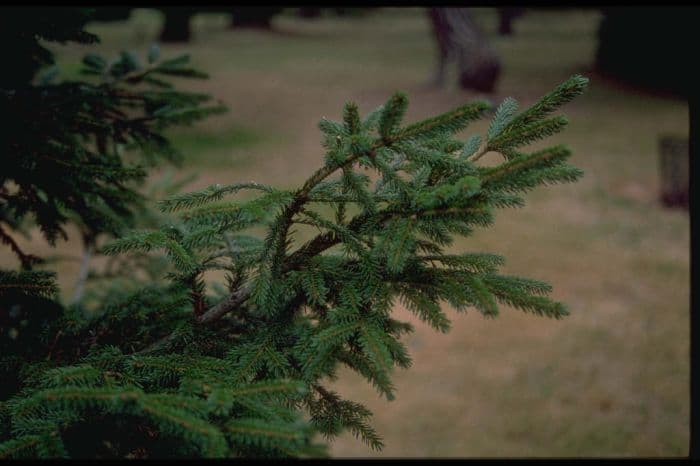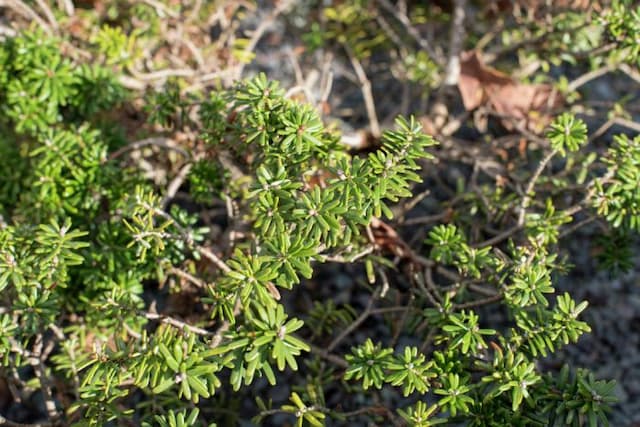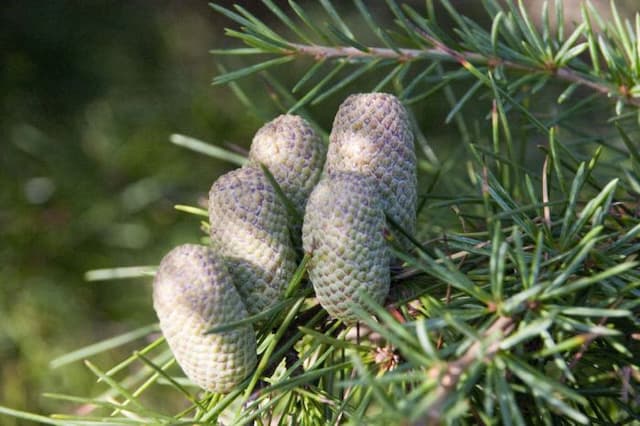Oriental Spruce Picea orientalis

ABOUT
The plant commonly known as Oriental spruce is a coniferous evergreen that boasts a dense, pyramidal shape with a conical crown, creating a classic Christmas tree silhouette in the landscape. Its branches extend horizontally from the central trunk, producing a layered appearance. The needles are short, somewhat four-sided, and attached individually to the branches. They offer a lush deep green hue, which sometimes carries a hint of blue or silver when light reflects off their waxy surface. Cones are a distinguishing feature of the Oriental spruce, starting off as pale green or purple and maturing to a woody brown. As they ripen, these cones dangle elegantly from the tips of the branches. The bark of the Oriental spruce is another notable characteristic; when young, it is smooth and has a reddish-brown color, but as the tree matures, it develops furrows and ridges, taking on a more rugged appearance. Overall, the Oriental spruce presents itself with a graceful and refined texture, thanks to its densely packed foliage and the delicate interplay of colors on its needles and cones. It exudes an air of robustness and durability while also providing a soft and inviting visual impact in gardens and natural landscapes.
About this plant
 Names
NamesFamily
Pinaceae
Synonyms
Oriental Spruce, Eastern Spruce, Caucasian Spruce
Common names
Abies orientalis, Picea excelsa var. orientalis, Pinus orientalis.
 Toxicity
ToxicityTo humans
The most common common name of Picea orientalis is Oriental spruce. Oriental spruce is not generally considered toxic to humans. However, ingesting parts of the plant is not advisable, as it is not intended for human consumption, and doing so may cause mild stomach upset or discomfort in some individuals due to the indigestible nature of many plant parts.
To pets
Oriental spruce, which is the most common common name of Picea orientalis, is generally not toxic to pets. Just like in humans, ingestion is not recommended as it may lead to gastrointestinal irritation or discomfort due to the indigestible nature of the plant material. However, it does not typically cause serious poisoning or long-term health consequences.
 Characteristics
CharacteristicsLife cycle
Perennials
Foliage type
Evergreen
Color of leaves
Green
Height
60 feet (18 meters)
Spread
30 feet (9 meters)
Plant type
Tree
Hardiness zones
4
Native area
Caucasus
Benefits
 General Benefits
General Benefits- Landscape Aesthetics: The Oriental spruce (Picea orientalis) provides visual interest due to its pyramidal shape and dense, dark-green foliage.
- Habitat Support: It offers habitat and shelter for birds and other wildlife in the garden.
- Shade Production: Due to its dense foliage, it can create shaded areas in the landscape, which can help cool the environment.
- Privacy: Tall and dense, it can serve as a natural privacy screen, blocking unwanted views and reducing noise pollution.
- Soil Stability: Its root system can help prevent soil erosion, especially in sloped areas.
- Drought Tolerance: Once established, it has a good resistance to drought, requiring less watering than some other species.
- Windbreak: This plant can be used in windbreak plantings to protect gardens and buildings from harsh winds.
 Medical Properties
Medical PropertiesThis plant is not used for medical purposes.
 Air-purifying Qualities
Air-purifying QualitiesThis plant is not specifically known for air purifying qualities.
 Other Uses
Other Uses- The wood of Picea orientalis, commonly known as Oriental spruce, can be used in the manufacture of musical instruments, particularly soundboards for pianos, due to its resonant qualities.
- Oriental spruce cones can be used as a natural decorative element in floral arrangements and crafts, adding a rustic touch to various designs.
- The robust nature of Oriental spruce wood makes it suitable for building outdoor structures such as gazebos, pergolas, and garden benches that can withstand harsh weather conditions.
- Small branches and twigs from the Oriental spruce can be utilized in model making, especially for creating realistic miniature trees and landscapes.
- Oriental spruce bark can be processed into mulch, which helps retain soil moisture and temperature, suppresses weed growth, and adds a decorative finish to garden beds.
- The dense foliage of the Oriental spruce provides excellent cover for birds, making it an ideal choice for creating wildlife-friendly gardens and nature reserves.
- Oriental spruce needles, which are rich in resins, can be used as kindling to help start fires more easily in camping and outdoor scenarios.
- The tree's symmetrical shape and attractive foliage make it a popular choice for use as a living Christmas tree during the holiday season.
- Oriental spruce is sometimes utilized in windbreaks or as a shelterbelt, its dense growth providing protection against strong winds and soil erosion.
- Due to its ornamental appeal, Picea orientalis is often planted in large parks and gardens for its aesthetic beauty and contribution to the landscape.
Interesting Facts
 Feng Shui
Feng ShuiOriental spruce is not used in Feng Shui practice.
 Zodiac Sign Compitability
Zodiac Sign CompitabilityOriental spruce is not used in astrology practice.
 Plant Symbolism
Plant Symbolism- Resilience and Strength: The Oriental spruce, like many conifers, is an evergreen that retains its needles year-round, symbolizing endurance and the ability to withstand harsh conditions.
- Renewal and Growth: As a tree that grows tall and straight, the Oriental spruce often represents upward movement and progress, suggesting new beginnings and continuous development.
- Longevity: With its potential to live for hundreds of years, the Oriental spruce can symbolize longevity and the passage of time.
- Peace and Tranquility: The dense, pyramidal form, and the calming green hues of the Oriental spruce are seen as embodying peace and calmness, often making them a choice for serene landscapes and gardens.
- Festivity and Celebration: Due to its resemblance to traditional Christmas trees, the Oriental spruce may be associated with the holiday season, joy, and the spirit of giving.
 Water
WaterThe Oriental spruce should be watered thoroughly, ensuring that the soil is moist but not saturated. During the growing season, water the plant with about 1.5 gallons per week. Adjust the amount during periods of rainfall or drought to maintain consistent soil moisture. Young trees require more frequent watering, while established trees can be watered less often. Always check the top few inches of soil for dryness before watering again.
 Light
LightThe Oriental spruce thrives best in full sun to partial shade. It is important to position the plant in a spot where it receives at least four to six hours of direct sunlight each day. Avoid locations where buildings or other plants might cast excessive shade on the spruce.
 Temperature
TemperatureOriental spruces prefer cooler temperatures and can tolerate temperatures as low as -30°F and as high as 90°F. The ideal temperature range for this plant is between 60°F and 75°F. It is a hardy plant that is well-suited for climates with cold winters and moderate summers.
 Pruning
PruningPrune the Oriental spruce to shape it and remove any diseased or dead branches, which helps prevent the spread of disease. Prune in late winter or early spring before new growth starts, as this is the best time for healing. Pruning is typically done once a year, but may vary based on the tree's growth and overall health.
 Cleaning
CleaningNot needed
 Soil
SoilThe Oriental Spruce requires well-draining, acidic soil with a pH between 5.5 and 6.5. An ideal mix could consist of equal parts peat, pine bark, and perlite or sand to ensure good drainage and aeration. Regularly monitor the soil's acidity, and if necessary, amend with sulfur to maintain the optimum pH range.
 Repotting
RepottingOriental Spruce trees are slow-growing and do not require frequent repotting. They should generally be repotted every 3 to 4 years to refresh the soil. Younger trees may need repotting sooner if they outgrow their pots, but mature trees can go longer intervals before needing a new container.
 Humidity & Misting
Humidity & MistingOriental Spruce trees are hardy and can tolerate a wide range of humidity levels. However, they prefer moderate to high humidity, ideally between 40% and 70%. As outdoor plants, they typically receive adequate humidity from the environment but may benefit from misting if grown in an unusually dry climate or indoor setting.
 Suitable locations
Suitable locationsIndoor
Ensure bright light, cool temperature, and well-draining soil for indoor Oriental Spruce.
Outdoor
Plant in well-draining soil, full sun to partial shade, and protect from strong winds.
Hardiness zone
4-7 USDA
 Life cycle
Life cycleThe life of Oriental Spruce (Picea orientalis) begins with seed germination, where conditions must be moist and cool for the seed to develop into a seedling. The seedling stage is marked by initial growth from the seed and establishment of the root system, followed by the development of a few needles. As the plant grows, it enters the sapling phase, characterized by increased growth in height and girth, along with the development of a more extensive branch structure. Upon reaching maturity, the Oriental Spruce produces cones, with female cones producing seeds and male cones releasing pollen. Pollination occurs typically through wind dispersion, fertilizing the seeds within the female cones. Finally, once mature seeds are dispersed by wind or gravity, the cycle begins anew given the right environmental conditions for germination.
 Propogation
PropogationPropogation time
Late winter-early spring
Picea orientalis, commonly known as Oriental spruce, is typically propagated through seeds, but the most popular method is by using semi-hardwood cuttings. Propagation from cuttings is ideally done in late summer. To propagate from cuttings, a gardener would select a healthy, semi-hardwood branch from the current year's growth. The cutting should be about 6 to 8 inches (15 to 20 centimeters) long and include several sets of needles. The lower needle sets are removed to expose the nodes, and the cut end is often treated with rooting hormone to encourage root development. The prepared cutting is then inserted into a pot filled with a mixture of peat and perlite or sand to provide good drainage and aeration. The environment around the cutting should be kept moist, and it is beneficial to provide a humidity dome or plastic wrapping to retain moisture levels until roots establish, which can take several months.









